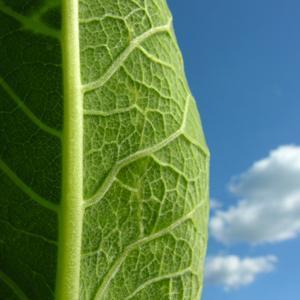
Scientists at the Massachusetts Institute of Technology have turned to Mother Nature for inspiration, inventing a device that mimics photosynthesis, the process plants use to convert sunlight and water into usable energy.
MIT chemistry professor Daniel Nocera, lead researcher on the artificial leaf project, says he and his colleagues took their cues from plants, which are literally buzzing with electricity.
"What happens is that sunlight comes in and hits the leaf and then the leaf immediately takes that sunlight and makes a wireless current," says Nocera.
During photosynthesis, the energy in sunlight splits water molecules into hydrogen and oxygen. The hydrogen joins with carbon dioxide to make sugar, an essential fuel for plant growth. In Nocera's laboratory, scientists replicated that chemical process using a silicon device about the size and shape of a playing card, only thinner. It's coated with nickel and cobalt catalysts that when exposed to water and ultraviolet light, accelerate a chemical reaction.
"So you can literally just take this bottle of water and we could take the chip, put the chip inside the bottle of water, and go holding it up in the sun and you would start seeing hydrogen and oxygen bubbles coming up."
The hydrogen is then recombined with the oxygen in a fuel cell to produce electricity. Nocera's work builds on previous research. John Turner of the National Renewable Energy Laboratory pioneered the concept in 1998 using materials too expensive and unstable for commercialization.
Nocera says his so-called practical artificial leaf uses less expensive materials, is more stable and more efficient than that earlier design. He says the challenge is to collect the gases coming off the silicon and store them until the energy is needed. "It has to be engineered still, we don't know how to do that." he adds. "It will be something that we will start doing soon. You'll be storing a fair amount of energy because this system is working at the efficiency more or less of the solar cell."
In laboratory experiments, Nocera's solar cell prototype operated continuously for 45 hours without a drop in electrical output. Nocera notes that it works in any type of water. "You can use natural water sources, which for us is a big deal, because if you are in rural parts of the world, especially where they are poor, it is really costly to bring in pure water and so, the fact that you can go 'over there' to a puddle and pick the water up and begin using it, is something that is very powerful for us."
Nocera believes the artificial leaf could be especially useful as an inexpensive source of electricity for low-income populations in developing countries. The goal, Nocera says, is to make each home its own power station. He predicts a commercial version of the artificial leaf will be on the market within three years.
cobalt: a chemical element; Cobalt is a hard silver-white metal, often mixed with other metals and used to give a deep blue-green colour to glass. 鈷
ultraviolet: of or using electromagnetic waves that are just shorter than those of violet light in the spectrum and that cannot be seen 紫外線的;利用紫外線的
Eco-Friendly Light Bulb Wins 環保燈泡獲大獎
Competition shows off super fuel-efficient automobiles
(來源:VOA 編輯:崔旭燕)
